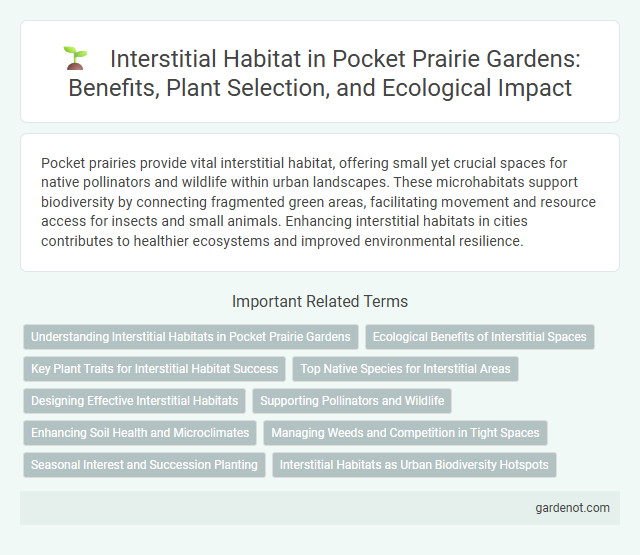Pocket prairies provide vital interstitial habitat, offering small yet crucial spaces for native pollinators and wildlife within urban landscapes. These microhabitats support biodiversity by connecting fragmented green areas, facilitating movement and resource access for insects and small animals. Enhancing interstitial habitats in cities contributes to healthier ecosystems and improved environmental resilience.
Understanding Interstitial Habitats in Pocket Prairie Gardens
Interstitial habitats in pocket prairie gardens serve as crucial microenvironments that support diverse soil organisms, insects, and seedlings by providing shelter and resources in the small spaces between plants. These habitats enhance ecosystem resilience and biodiversity by facilitating nutrient cycling, pollination, and pest control within urban green spaces. Understanding the dynamics of interstitial habitats helps optimize pocket prairie design to promote ecological functions and sustainable urban habitat restoration.
Ecological Benefits of Interstitial Spaces
Interstitial habitats within pocket prairies enhance biodiversity by providing critical microhabitats for pollinators, ground-nesting birds, and beneficial insects. These narrow spaces promote soil health through increased microbial activity and improve water infiltration, reducing erosion. The ecological benefits of interstitial spaces contribute to resilient ecosystems and support the overall functionality of pocket prairie environments.
Key Plant Traits for Interstitial Habitat Success
Key plant traits for interstitial habitat success in pocket prairies include deep root systems that enhance soil stability and water infiltration. Plants with high drought tolerance and rapid growth rates improve resilience and resource capture in microhabitats. Additionally, species exhibiting tolerance to varying light conditions and compacted soils optimize survival and ecological function within interstitial spaces.
Top Native Species for Interstitial Areas
Top native species for interstitial habitats in pocket prairies include little bluestem (Schizachyrium scoparium), prairie dropseed (Sporobolus heterolepis), and wild bergamot (Monarda fistulosa). These species thrive in microhabitats between larger plants, providing critical cover and resources for pollinators and ground-nesting insects. Their deep root systems enhance soil stability and promote biodiversity within these unique ecological niches.
Designing Effective Interstitial Habitats
Designing effective interstitial habitats within pocket prairies involves creating small, diverse microhabitats that support native pollinators, beneficial insects, and soil microorganisms. Incorporating varied plant species with staggered blooming periods enhances resource availability throughout the growing season, promoting ecosystem resilience. Optimizing spatial arrangement and soil conditions in these interstitial zones maximizes biodiversity and ecological connectivity within urban green spaces.
Supporting Pollinators and Wildlife
Interstitial habitats within pocket prairies provide critical microenvironments that support diverse pollinators and wildlife by offering nesting sites, food resources, and shelter. These small-scale, naturally occurring patches enhance biodiversity by connecting larger habitat areas, facilitating movement and genetic exchange among species. Maintaining diverse plant species in these habitats ensures continuous blooming periods, vital for sustaining pollinator populations year-round.
Enhancing Soil Health and Microclimates
Interstitial habitats within pocket prairies significantly enhance soil health by promoting microbial diversity and increasing organic matter content. These microenvironments improve moisture retention and create favorable microclimates that support native plant growth and resilience against environmental stressors. By fostering a complex soil structure, interstitial habitats contribute to nutrient cycling and long-term ecosystem stability.
Managing Weeds and Competition in Tight Spaces
Managing weeds and competition in pocket prairies requires targeted strategies to preserve interstitial habitats that support native biodiversity. Employing selective mowing, hand weeding, and timely herbicide application in tight spaces controls invasive species without disrupting beneficial plants. Enhancing soil health and promoting native seed diversity further strengthens resilience against competitive weeds in these confined natural areas.
Seasonal Interest and Succession Planting
Pocket prairies provide vital interstitial habitats that support biodiversity through seasonal interest by featuring varied flowering times and color changes that attract pollinators across spring, summer, and fall. Succession planting within pocket prairies ensures continuous ecological function by layering early bloomers, mid-season flowers, and late-season seed producers, fostering habitat stability and resilience. This dynamic planting strategy enhances soil health, supports native wildlife, and mitigates invasive species by maintaining a diverse and evolving plant community.
Interstitial Habitats as Urban Biodiversity Hotspots
Interstitial habitats in pocket prairies serve as critical urban biodiversity hotspots, providing refuge for diverse invertebrates, pollinators, and small vertebrates amidst city landscapes. These microhabitats enhance ecological connectivity by supporting native plant species and facilitating gene flow between fragmented green spaces. Conserving pocket prairie interstitial zones boosts urban resilience, promotes ecosystem services, and fosters environmental sustainability in metropolitan areas.
Interstitial habitat Infographic

 gardenot.com
gardenot.com